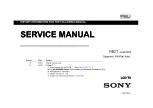
4
manufacturer’s instructions have been adhered to.
10) Power Sources — This TV should be operated only from the type of
power sources indicated on the electrical nameplate. If you are not
sure of the type of power supplied to your home, consult your
appliance dealer or local power company if TV’s intended to
operate on battery power or other sources. Refer to the operation
instructions.
11) Grounding or Polarization — This TV is equipped with a polarized
alternating current line plug (a plug having one blade wider than
the other). This plug will fit into the power outlet only one way.
This is a safety feature. If you are unable to insert the plug fully
into the outlet, try reversing the plug. If the plug should still fail
to fit, contact your electrician to replace your outlet.
12) Power Cord Protection — Power supply cords should be routed so
that they are not likely to be walked on or pinched by items placed
on or against them. Pay particular attention to cords or plugs,
convenience receptacles, and the point where they exit from the
appliance.
13) Overloading — DO NOT overload wall outlets and extension cords
as this may result in a fire outbreak or electric shock.
14) Power Lines — An outside antenna system should not be located in
the vicinity of overhead power lines, electric lights and power
circuits, or where it can fall into such power lines or circuits. When
installing an outside antenna system, extreme care should be
taken to avoid touching such power lines or circuits as contact with
them may be fatal.
15) Outdoor Antenna Grounding
— If an outside antenna or
cable system is grounded so
as to provide some
protection against voltage
surges and built-up static
charges, follow Article 810 of
the National Electrical Code,
NSI/NFPA No.70, which
provides information with
respect to proper grounding
of the mast and supporting
structure, grounding of the
lead-in wire to an antenna
discharge unit, size of
grounding conductors,
location of antenna
discharge unit, connection to grounding electrodes,
and requirements for the grounding electrode. (Fig. A)
16) Lightning Precaution — For added protection for the TV receiver during a
lightning storm or when it is left unattended for extended periods of time,
unplug it from the wall outlet and disconnect the antenna or cable system.
This will prevent damage to the TV due to lightning and power line surges.
17) Modifications — Any changes or modifications to this product that are
not expressly approved by the Federal Communications Commission
could void the user’s authority to operate the equipment.





































